I had last sailed out to Bull Island the day after the equinox, March 20, an astronomical event overshadowed by the onset of the U.S. pandemic. Several surprises had greeted me before I set foot on the island: a surfaced cormorant gripping an eel in its beak at the Shark Hole, and the news at the dock that the ferry service had been suspended due to the pandemic. The island was not closed (beaches would become off-limits in the next month). So I began a semi-planned walk.
There were only a couple other people on the island, and I would not have any further human contact that day. An earlier idea for a hike changed to retracing the steps of a January walk. This first full day of spring had an appropriate display, as part of my path was petaled with yellow jessamine.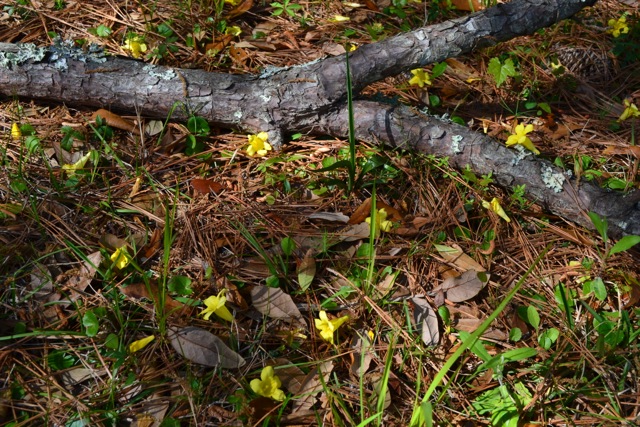 As I headed north down the beach toward the Boneyard, the effects of erosion had left some new microhabitats above the beach, where flora were now influenced by direct sunlight and exposure to salt spray.
As I headed north down the beach toward the Boneyard, the effects of erosion had left some new microhabitats above the beach, where flora were now influenced by direct sunlight and exposure to salt spray.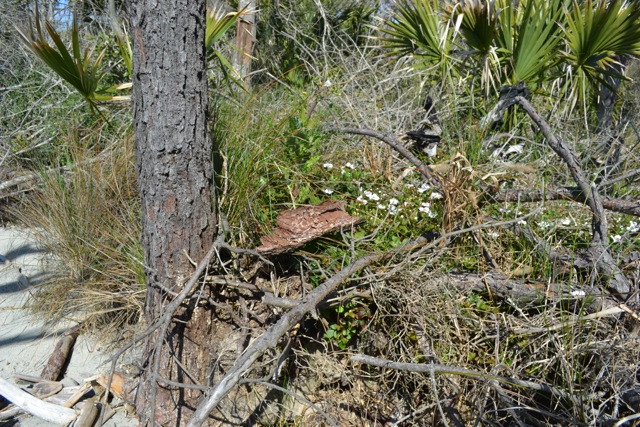 These tiny ledges were new, and made me wonder about knowing this island, a place I have been exploring regularly for over fifteen years. Though I was following a course almost the same as in January, it was not Groundhog Day. In The Old Ways, Robert McFarlane, British author exploring nature and landscape, asserted “the belief that they might come to know their chosen place utterly because of its boundedness. And all had, after long acquaintance, at last understood that familiarity with a place will lead not to absolute knowledge but only ever to further enquiry.” Yes.
These tiny ledges were new, and made me wonder about knowing this island, a place I have been exploring regularly for over fifteen years. Though I was following a course almost the same as in January, it was not Groundhog Day. In The Old Ways, Robert McFarlane, British author exploring nature and landscape, asserted “the belief that they might come to know their chosen place utterly because of its boundedness. And all had, after long acquaintance, at last understood that familiarity with a place will lead not to absolute knowledge but only ever to further enquiry.” Yes.
It would take perhaps daily walks through the Boneyard and a high level of attention to keep track of the changes to the “skeletons” on this distinctive beach. Yet I didn’t recall a certain pine tree walking across the strand.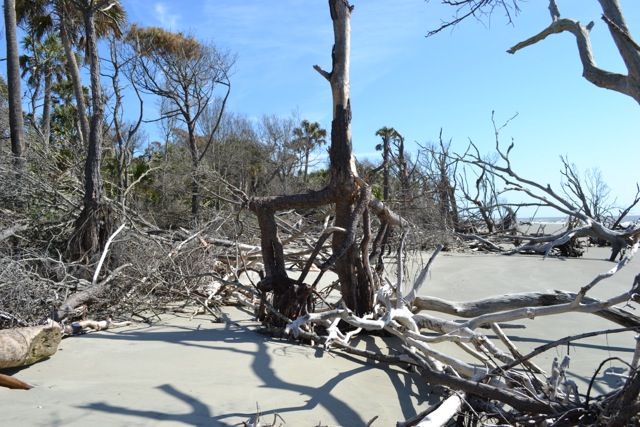 I searched out the young dolphin carcass I found here in January, and the remains included scattered vertebrae.
I searched out the young dolphin carcass I found here in January, and the remains included scattered vertebrae.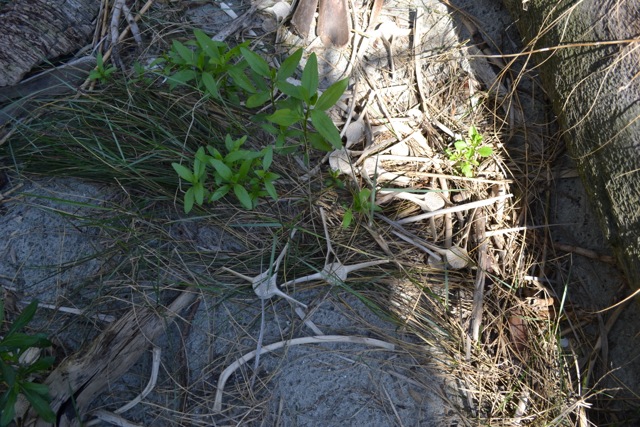 The old infrastructure of a disappeared bank was more naked than ever, and the swash running across the beach from New Pond had created a microdelta.
The old infrastructure of a disappeared bank was more naked than ever, and the swash running across the beach from New Pond had created a microdelta.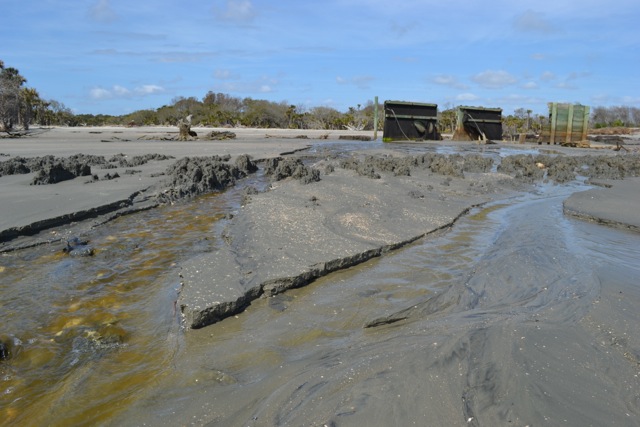 Where the dike started around Jacks Creek, new leaves of Hercules Club burst out in the beauty of fresh foliage.
Where the dike started around Jacks Creek, new leaves of Hercules Club burst out in the beauty of fresh foliage.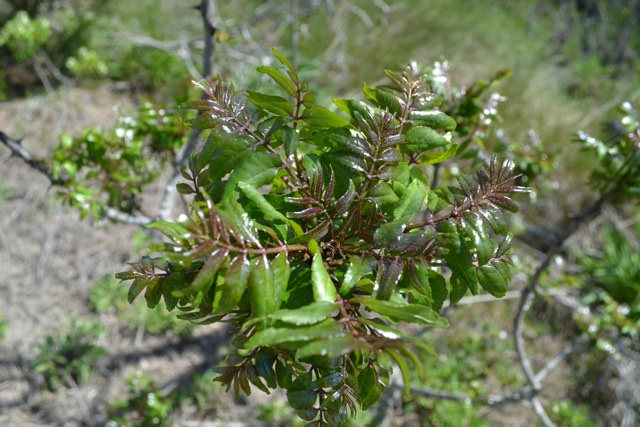
My path continued out on the cross dike spanning the Jacks Creek impoundment. Migratory waterfowl and wading birds populated the waters, and ahead on the dike a great blue heron spread its wings for drying, a habit of cormorants. Also soaking up the sun on the bank were a number of alligators. The “T” in the dike connecting to the Sheepshead Ridge Road divided the impoundment into three sections: the large impoundment behind, the section to the east of the road (old dune ridge), and the section to the west.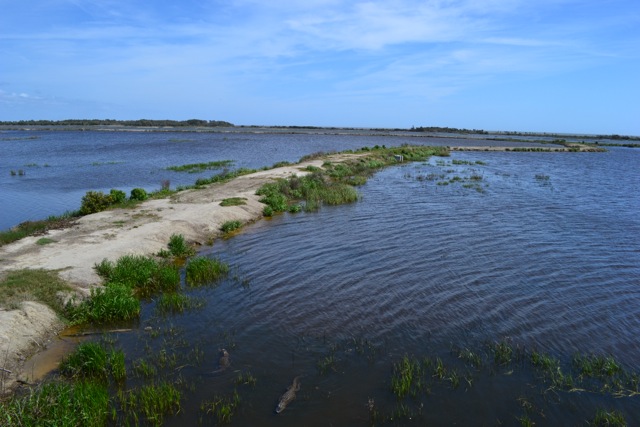
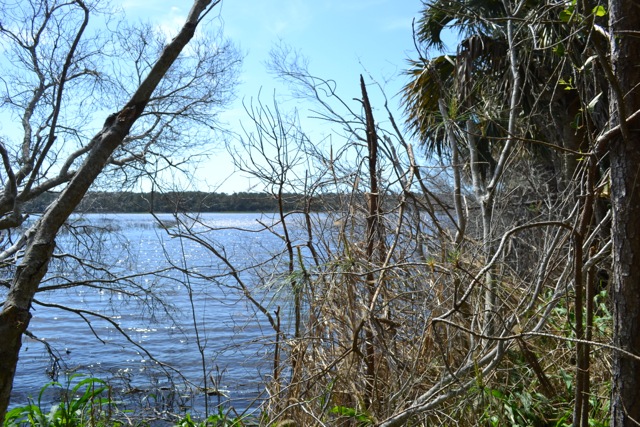
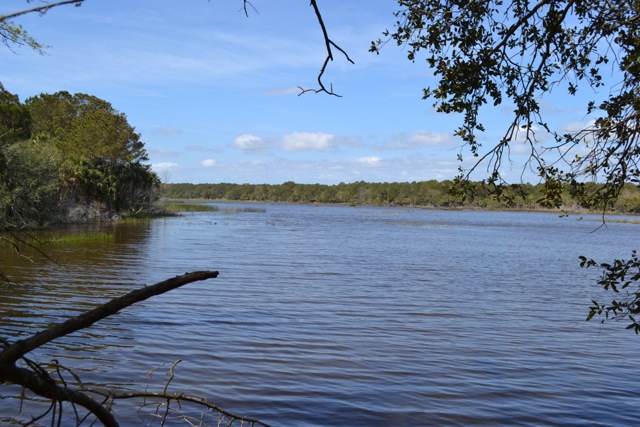 After passing the first section of road, and continuing on longer spans of road toward the dock, my thoughts strayed back to the pandemic, and a time out of joint.
After passing the first section of road, and continuing on longer spans of road toward the dock, my thoughts strayed back to the pandemic, and a time out of joint.
Reversing this walk on the last day of July, another scalding 90+ degrees of heat, I found that last section of road before the Observation Tower and Jacks Creek unmowed, and segments thickly covered with knee deep grass. I would have turned around if wearing shorts and sandals. A long black rat snake slithered through the grass at the beginning, but I carried on until reaching the tower and dike, colonized by the ruderal community of flora. 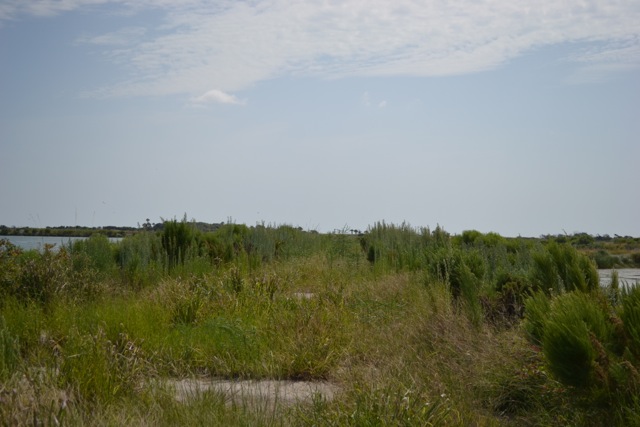 When out on the middle of the dike, I was startled from behind by a deep squawk on a flyby of the largest great blue heron I have ever seen, its wing span suggesting a Jurassic pterosaur. A main colonizer of the bank was pokeweed, and piles of scat filled with the berries were scattered liberally around the ground.
When out on the middle of the dike, I was startled from behind by a deep squawk on a flyby of the largest great blue heron I have ever seen, its wing span suggesting a Jurassic pterosaur. A main colonizer of the bank was pokeweed, and piles of scat filled with the berries were scattered liberally around the ground.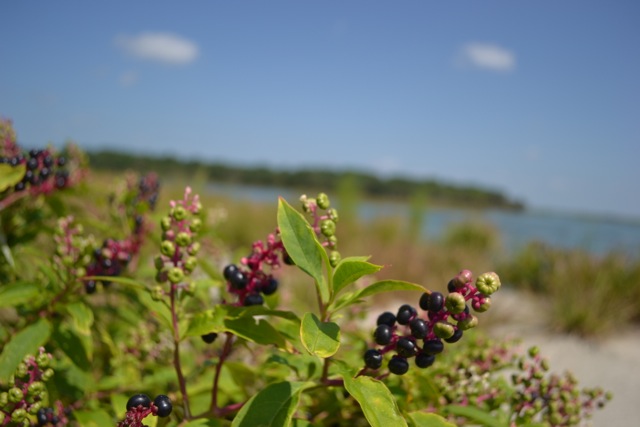 Members of the morning glory family added color to the dike edges, and a grass with towering plumes swayed in the wind.
Members of the morning glory family added color to the dike edges, and a grass with towering plumes swayed in the wind.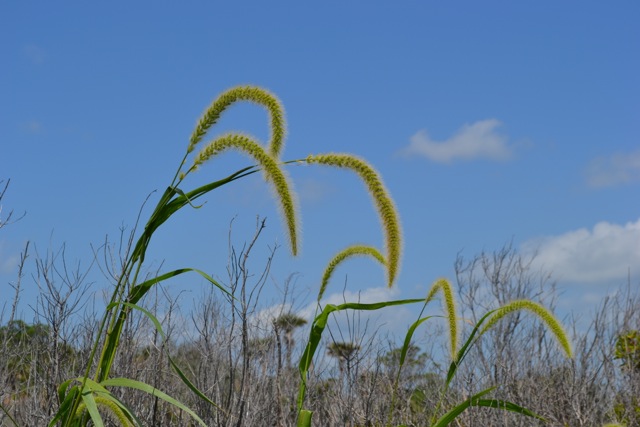
After cooling off in the ocean and lunching at the Boneyard, I began the walk back south on the beach. Dead low tide, steady southwest breeze in the nose, blazing sunlight, oppressive heat. I shared the beach with a few passengers from the resumed ferry service, passing them as I maintained a homeward bound pace, and rationing the last of my water. My garb of long sleeves, sunglasses, buff pulled up on my face, and hat was a sharp contrast to several men I passed on the Beach Road, shirtless and shoeless. Back at the dock, I secured gear, raised sail, and cast off for what projected to be a rapid sail home. The casting off was a new technique prompted by my last departure from the dock. The southwest wind that March day was stronger, and I would have gladly accepted help with the cast off by some of the usual suspects – Will? Nick? Chris? Greg? Jerry? Sarah? Jennifer? Yet I was the last person left on the island. The run out Summerhouse Creek in March was made on a full plane despite several gallons of water leaked into my hull. I made the embarrassing decision to make a “chicken” jibe, seemingly prudent at the time to protect the rig from the more extreme maneuver. I admit, I chickened several more times on that sail.
The wind was brisk on this July day, but with gallons removed from the hull and leak repaired, it was “jibe ho”. I had several intervening sails between the two island trips, used as “sea trials” after the repair. The successful repair added a skip to the skipper’s step, only slightly dampened by a collision with a submerged oyster bank in Bulls Bay. I was relieved to avoid another collision when a loggerhead turtle surfaced feet in front of my bow on one of those trials. In the process of knowing the island and its surrounds, I understood that sailing enabled a continued enquiry. That July sail out to the island renewed an awareness of my cultivated intimacy with the wind.
Bob, I think this was beautifully written I felt a part of the scene. It could hac as easily been the !600’s and the first exploration. loved it. Thanks for including me.
Glad you came along for the adventure, Gary. I did have a crew member for the last sail. Was well behaved for a while, exploring the rigging, until it bit me through me shirt. Ungrateful, shameful.
Thank you, Bob, for another excursion to a very special place. Your writing put me right back onto the island and encourages me to return in person soon. Keep posting, there are a lot of us who enjoy the reading very much.
The ferry is running again and access is available. I’ll be back out there again – perhaps in a little cooler weather.
The island is a physical reminder that… the only thing constant in life is…Change!!
A wonderful vicarious trip to the island 🙂 G
I have been doing vicarious too, but enjoyed the real thing.
The island and refuge in general continue to undergo change. There is also that change in consciousness that can make things new.
Miss this place so very much, and being there with you, Dad. Thanks for taking us there virtually, with your picturesque words and scenic photos.
Love, Sara
We will look forward to all going there in the near future.
Thanks Bob – enjoyed the read and for a second I was there with you! Thanks
Just a second? Post vaccination we will get out there for the whole thing.
Thanks for the wonderful escape from dealing with the hurricane and earthquake!
Dynamic duo in the Tar Heel State. We were spared locally by the tropical storm/hurricane. What a 2020!
Enjoyed the words and especially the pictures of Bull’s Island. Takes me back to the Bull Bay Festival when my sister and I joined you on the island. I have to say you are brave confronting temperatures in the 90’s. A walk in nature sure can put things back into perspective during these troubling times.
My partial day on the island helps me maintain my appreciation for the hard work of the turtle crew in the north part of the refuge with the loggerhead nest protection program. Not sure how they survived the three weeks solid of 90+ days.